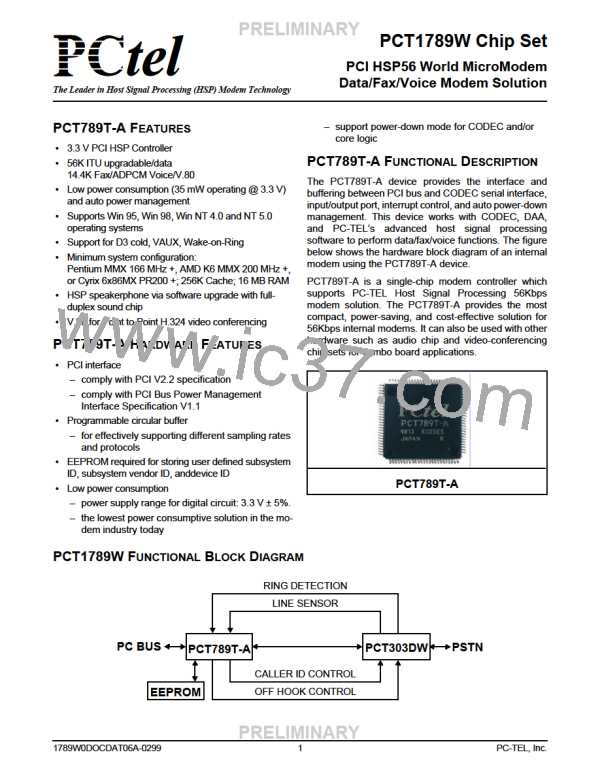PRELIMINARY
PCT1789W DATA SHEET
PCT303DW FUNCTIONAL DESCRIPTION
!!
The digital interface consists of a single, synchronous allowing software control of the secondary frames. As
serial link which communicates both telephony and an alternative method, the FC pin can serve as a
control data.
hardware flag for requesting a secondary frame. The
external DSP can turn on the 16-bit TX mode by setting
the SB bit of register 1. In the 16-bit TX mode, the
hardware FC pin must be used to request secondary
transfers.
In Serial mode 0 or 1, the PCT303D operates as a
master, where the master clock (MCLK) is an input, the
serial data clock (SCLK) is an output, and the frame
sync signal (FSYNC) is an output. The MCLK frequency
and the value of the sample rate control registers 7, 8, 9 Figure 13 and Figure 14 illustrate the secondary frame
and 10 determine the sample rate (Fs). The serial port read cycle and write cycle, respectively. During a read
clock, SCLK, runs at 256 bits per frame, where the frame cycle, the R/W bit is high and the 5-bit address field
rate is equivalent to the sample rate. Refer to “Clock contains the address of the register to be read. The
Generation Subsystem” on page 23 for more details on contents of the 8-bit control register are placed on the
programming sample rates.
SDO signal. During a write cycle, the R/W bit is low and
the 5-bit address field contains the address of the
register to be written. The 8-bit data to be written
immediately follows the address on SDI. Only one
register can be read or written during each secondary
frame. See “PCT303DW Control Registers” on page 41
for the register addresses and functions.
The PCT303DW transfers 16-bit or 15-bit telephony
data in the primary timeslot and 16-bit control data in the
secondary timeslot. Figure 11 and Figure 12 show the
relative timing of the serial frames. Primary frames occur
at the frame rate and are always present. To minimize
overhead in the external DSP, secondary frames are
present only when requested.
In serial mode 2, the PCT303D operates as a slave
device, where the MCLK is an input, the SCLK is a no
connect, and the FSYNC is an input. In addition, the
RGDT/FSD pin operates as a delayed frame sync (FSD)
and the FC/RGDT pin operates as ring detect (RGDT).
Note that in this mode, FC operation is not supported.
Two methods exist for transferring control information in
the secondary frame. The default power-up mode uses
the LSB of the 16-bit transmit (TX) data word as a flag to
request a secondary transfer. In this mode, only 15-bit
TX data is transferred, resulting in a loss of SNR but
Communications Frame 1 (CF1)
(CF2)
Secondary
Primary
Primary
FSYNC
FC
0
D15-D1 D0=1 (Software FC Bit)
Secondary
SDI
XMT Data
XMT Data
RCV Data
Update
Secondary
Update
SDO
RCV Data
16 SCLKS
128 SCLKs
256 SCLKs
Figure 11 Software FC/RGDT Secondary Request
PRELIMINARY
PC-TEL, Inc.
20
1789W0DOCDAT06A-0299

 ETC [ ETC ]
ETC [ ETC ]